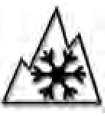Jeep Cherokee (KL): Radial Ply Tires. Tire Types. Run Flat Tires
WARNING! Combining radial ply tires with other types of tires
on your vehicle will cause your vehicle to handle
poorly. The instability could cause a collision. Always
use radial ply tires in sets of four. Never
combine them with other types of tires. Tire Repair If your tire becomes damaged, it may be repaired if it
meets the following criteria: Consult an authorized tire dealer for tire repairs and
additional information.
Damaged Run Flat tires, or Run Flat tires that have
experienced a loss of pressure should be replaced immediately
with another Run Flat tire of identical size and
service description (Load Index and Speed Symbol). All Season tires provide traction for all seasons (Spring,
Summer, Fall and Winter). Traction levels may vary
between different all season tires. All season tires can be
identified by the M+S, M&S, M/S or MS designation on
the tire sidewall. Use all season tires only in sets of four;
failure to do so may adversely affect the safety and
handling of your vehicle. Summer Or Three Season Tires - If Equipped Summer tires provide traction in both wet and dry
conditions, and are not intended to be driven in snow or
on ice. If your vehicle is equipped with Summer tires, be
aware these tires are not designed for Winter or cold
driving conditions. Install Winter tires on your vehicle
when ambient temperatures are less than 40F (5C) or if
roads are covered with ice or snow. For more information,
contact an authorized dealer. Summer tires do not contain the all season designation or
mountain/snowflake symbol on the tire sidewall. Use
Summer tires only in sets of four; failure to do so may
adversely affect the safety and handling of your vehicle. WARNING! Do not use Summer tires in snow/ice conditions. You
could lose vehicle control, resulting in severe injury
or death. Driving too fast for conditions also creates
the possibility of loss of vehicle control. Some areas of the country require the use of snow tires
during the Winter. Snow tires can be identified by a
"mountain/snowflake" symbol on the tire sidewall. Snow tires generally have lower speed ratings than what
was originally equipped with your vehicle and should
not be operated at sustained speeds over 75 mph
(120 km/h). For speeds above 75 mph (120 km/h) refer to
original equipment or an authorized tire dealer for
recommended safe operating speeds, loading and cold
tire inflation pressures. While studded tires improve performance on ice, skid
and traction capability on wet or dry surfaces may be
poorer than that of non-studded tires. Some states prohibit
studded tires; therefore, local laws should be
checked before using these tire types. Run Flat tires allow you the capability to drive 50 miles
(80 km) at 50 mph (80 km/h) after a rapid loss of inflation
pressure. This rapid loss of inflation is referred to as the
Run Flat mode. A Run Flat mode occurs when the tire
inflation pressure is of/or below 14 psi (96 kPa). Once a
Run Flat tire reaches the run flat mode it has limited
driving capabilities and needs to be replaced immediately.
A Run Flat tire is not repairable.
It is not recommended driving a vehicle loaded at full
capacity or to tow a trailer while a tire is in the run flat
mode. See the tire pressure monitoring section for more information.Radial Ply Tires
Tire Types
All Season Tires - If Equipped
Snow Tires
 If you need snow tires, select
tires
equivalent in size and type to the original
equipment tires. Use snow tires
only in sets of four; failure to do so
may adversely affect the safety and
handling of your vehicle.
If you need snow tires, select
tires
equivalent in size and type to the original
equipment tires. Use snow tires
only in sets of four; failure to do so
may adversely affect the safety and
handling of your vehicle.Run Flat Tires - If Equipped
 Tire Pressure. Tire Inflation Pressures. Tire Pressures For High Speed Operation
Tire Pressure. Tire Inflation Pressures. Tire Pressures For High Speed Operation
Other materials:
Specifications
Frame dimensions
Frame dimensions are listed in millimeter scale.
All dimensions are from center to center of Principal
Locating Point (PLP), or from center to center of PLP
and fastener location (Fig. 6).
Fig. 6 Frame DimensionsFrame torque specifications
DESCRIPTION TORQUE
Front Skid Pl ...

